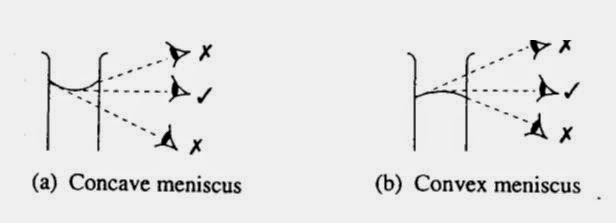Accuracy VS Precision
To make it easier to understand, a target and darts analysis was used.
As shown in the picture, precision is basically consistency, or as the picture also says, reproducibility. Accuracy is, as the picture shows, how 'correct' the result is, or rather, how close the result is to the right value, in this case, the bull's eye.
Some examples of accuracy in measuring instruments:
Ruler - 0.1cm/1mm
Vernier Caliper - 0.01cm/0.1mm
Micrometer Screw Gauge - 0.001cm/0.01mm
These measuring instruments are accurate up to a different number of decimal places, the more decimal places, the closer the measurement is to the exact length of the object being measured.
We also learnt how to read the meniscus of liquids. There are two types of menisci - concave and convex. This picture shows how to read each:
Then, we learnt about estimating the area of irregular things. For example:
Firstly, divide the figure into small squares like this:
To estimate the area, look at the parts of the figure in the squares. If a square is half or more than half occupied, count the square as part of the figure's area. If this is not the case, the square is not counted.
After counting x squares, multiply the area of each square by x to get the estimated area of the figure.
The smaller the squares used, the more accurate the estimation is.
For measuring time, we use stopwatches. There are yet again, two types of stopwatches - analogue and digital. The analogue stopwatch measures to an accuracy of 0.1s, while the digital measures up to 0.01s, so clearly, the digital is more accurate than the analogue stopwatch. However, because of our human reaction error, the second decimal place when using a digital stopwatch is not counted, so an analogue stopwatch is just as useful as the digital.
Another way of measuring time is the ticker-tape timer. As shown in the picture below:
The distance between every two dots is the movement made in 0.02s, so since there are 10 dots after the first in the picture, a total of 0.2s has elapsed (Just imagine using this to time 20s, 1000 dots, how fun counting).
The time for a pendulum to make an oscillation is called the period. An oscillation is counted when the pendulum passes the fudicial line after passing it before. Basically, it's the time taken for a whole swing from left to right.
The end of this term has come (lessons at least).
SEE YOU AND HAVE FUN





No comments:
Post a Comment